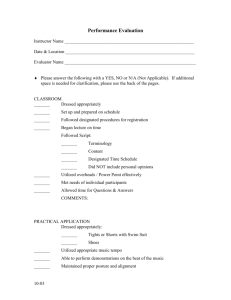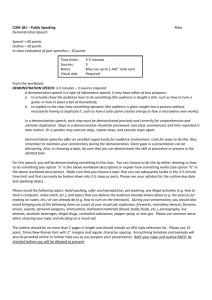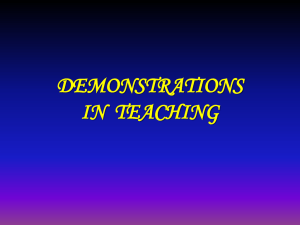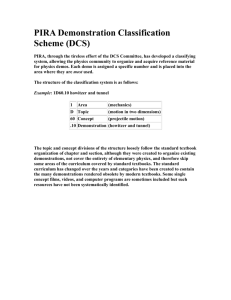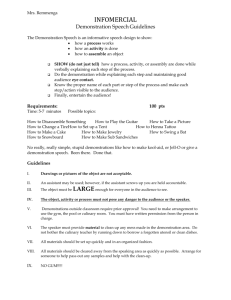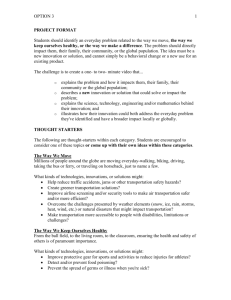Demonstration Book - Christian County Cooperative Extension
advertisement
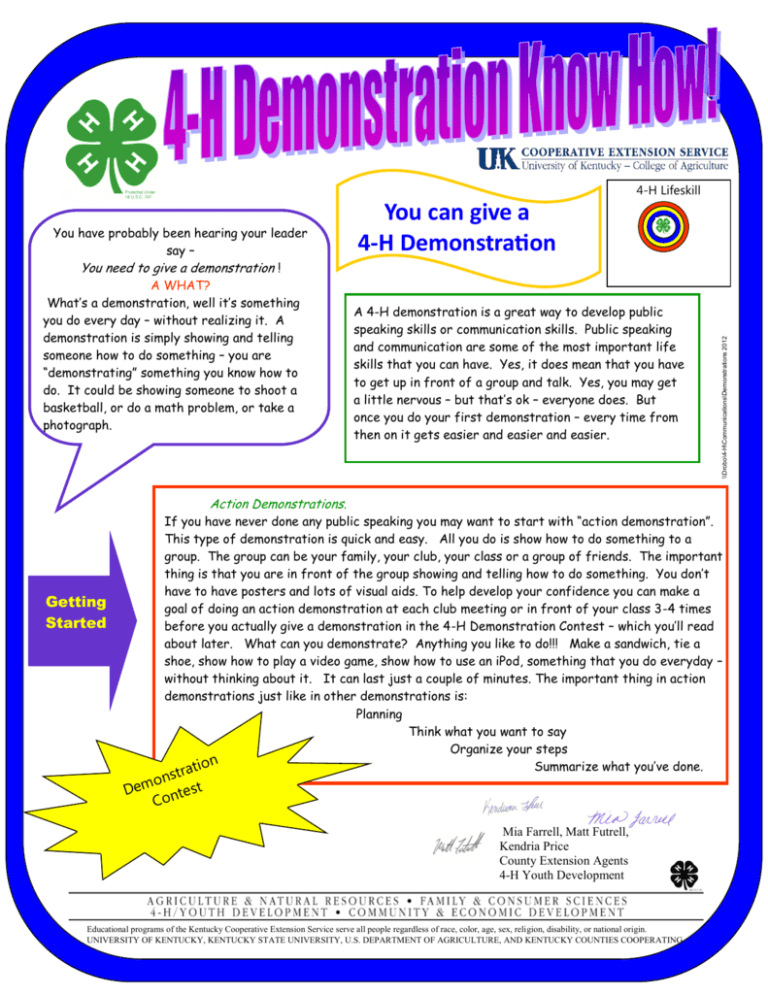
4-H Lifeskill Getting Started A 4-H demonstration is a great way to develop public speaking skills or communication skills. Public speaking and communication are some of the most important life skills that you can have. Yes, it does mean that you have to get up in front of a group and talk. Yes, you may get a little nervous – but that’s ok – everyone does. But once you do your first demonstration – every time from then on it gets easier and easier and easier. \\Drobo\4-H\Communications\Demonstrations 2012 You have probably been hearing your leader say – You need to give a demonstration ! A WHAT? What’s a demonstration, well it’s something you do every day – without realizing it. A demonstration is simply showing and telling someone how to do something – you are “demonstrating” something you know how to do. It could be showing someone to shoot a basketball, or do a math problem, or take a photograph. You can give a 4-H Demonstration Action Demonstrations. If you have never done any public speaking you may want to start with “action demonstration”. This type of demonstration is quick and easy. All you do is show how to do something to a group. The group can be your family, your club, your class or a group of friends. The important thing is that you are in front of the group showing and telling how to do something. You don’t have to have posters and lots of visual aids. To help develop your confidence you can make a goal of doing an action demonstration at each club meeting or in front of your class 3-4 times before you actually give a demonstration in the 4-H Demonstration Contest – which you’ll read about later. What can you demonstrate? Anything you like to do!!! Make a sandwich, tie a shoe, show how to play a video game, show how to use an iPod, something that you do everyday – without thinking about it. It can last just a couple of minutes. The important thing in action demonstrations just like in other demonstrations is: Planning Think what you want to say Organize your steps n o i Summarize what you’ve done. t ra t ons Dem ntest Co Mia Farrell, Matt Futrell, Kendria Price County Extension Agents 4-H Youth Development Educational programs of the Kentucky Cooperative Extension Service serve all people regardless of race, color, age, sex, religion, disability, or national origin. UNIVERSITY OF KENTUCKY, KENTUCKY STATE UNIVERSITY, U.S. DEPARTMENT OF AGRICULTURE, AND KENTUCKY COUNTIES COOPERATING 4-H Demonstration Contest Being in the 4-H Demonstration Contest is exciting!!! You will be learning about your public speaking ability. The demonstration contest provides you an opportunity to have your skills evaluated. You will have the opportunity to have recognition. If your skills are the best, you will get the opportunity to advance to area level, and possibly state level contests. Before you begin it is important to read the rules. When is the contest? What categories are there? How much time can your demonstration use? Check the score sheet The rules for the Kentucky 4-H Demonstration Contest are included in this handout. Planning Your Demonstration Choosing a Topic – what do I want to show and tell about Answer these questions: What do I like to do? What 4-H projects am I taking? What do I know something about? What would I like to teach someone how to do? What would I like to learn more about? Imagine yourself showing someone one of these things. Narrow the topics above so that you can thoroughly cover the subject matter in the time limit. (For example: broad topic - Photography – smaller – how to take great photographs) Make sure your demonstration is something YOU like and feel comfortable doing – this is your demonstration – be sure and do something that you like and know something about. After thinking about what you like to do and your 4-H projects, or what you would like to learn more about, think how to take great photographs (narrowed topic) for the 4-H demonstration. There are three parts to a demonstration and it’s a good idea to have a poster for each part. Introduction Body Conclusion. The introduction and conclusion are “attention getters”. The introduction helps the audience look forward to what you are going to say, the conclusion makes the audience want to do themselves whatever you demonstrated. These two parts can be hard to write, because you want them to be catchy and creative! Writing the body of your demonstration first should help you think of something that will make the audience want to listen and you won’t waste time trying to think of something. You don’t even have think of a catchy title until you have written what you want to demonstrate – if you have one great – but again don’t waste time when you could be getting organized. 2 Body This is all the information you want the audience to learn from your demonstration. What do you want to accomplish by demonstrating this topic? What are the steps you want to cover – what are the things you are going to show how to do? What will you have at the end of the demonstration? Be sure and do some research. Make sure all the information that you are giving out is correct, don’t just sit down and start writing, go to your project book or a research based website and make sure your information is correct. Always remember – what is it I want the audience to do with the information I am giving them? You are the teacher, what will the audience know when you are finished? What do I want to cover in my demonstration? Example: What do people need to know to take great photographs? 1. 2. 3. 4. Different types of cameras The parts of their camera and what they do Don’t just snap - plan Eagles eye view and snails eye view. Introduction Think about what you can say that would make you want to listen to your own demonstration. How much will you listen if you start your demonstration with: Hello, my name is ___________, the title of my demonstration is “Taking Pictures” and I am going to demonstrate how to take pictures. BORING!! Instead you can ask a question, tell a short, short story, or even an appropriate joke. How about this? Have you ever watched a beautiful sunset and wished you could remember it forever – you can – with some basic information about photography. Hello my name is ________ and I am going to show you how to “Capture the Moment” in photographs. Which demonstration would you rather listen to? Conclusion Make it catchy – so the audience will remember your demonstration and will want to do what you taught them. This is your chance to impress the audience one more time. Be sure and site where you got your information. • Re-emphasize main points. • Call for an audience action. • Show the benefit of others doing this activity. Remember: • Conclusions are brief, you aren’t doing the entire demonstration again, just summarizing the main points. Make your project demonstration sound finished. Here’s an example To Capture the Moment in photographs - you must know what type of camera you have, and what it will do, think before you snap and remember to use an eagle’s eye and snails eye view to add interest to your photographs. Doing these things will help you be able to “Capture the Moment” in photographs and share memories with your family and friends. The information for my demonstration came from: my 4-H photography project book. (show the book) Are there any questions? Thank you—this concludes my demonstration. Be sure and ask for questions when you are finished. 3 Using Visual Aids in Your 4-H Project Demonstration Of course you will have visual aids when you do a demonstration, but in addition to what you need to show, having a poster helps illustrate what you are showing and helps the audience follow along. Sometimes a large visual aid (such as a chart, poster, picture, model, or graph) can help explain information more quickly and clearly than words can. Having a poster with a diagram of the parts of a camera will help the audience see what you are showing on the camera. Having a poster with photographs can help the audience understand what you are talking about. The photographs have to be large enough so everyone can see the illustration. If you are doing a foods demonstration, you will want a poster with the recipe. • Preparing a visual aid: Make it large enough so that everyone in the audience can easily see/read it. Keep it uncluttered and simple: too much information will be distracting You can hand letter your poster or you can use computer generated letters. Using a visual aid: • Show visual aids only during the part of the project demonstration when they relate to what you are saying. You will have an easel to hold your posters. Practice putting one behind the other; don’t lay them on the floor. • Point specifically to the part of the visual aid you are referring to - use a pointer, a dowel rod or even a ruler. • Don’t hide behind a large visual aid; instead, stand beside it. Practice, Practice, Practice Practice Your 4-H Demonstration Write your demonstration on note cards At home, practice delivering your project demonstration. • Don’t read your demonstration, but try using the note cards to remind yourself of what you want to demonstrate. • Don’t memorize your demonstration, but have key steps highlighted on the note cards so that you don’t leave anything out. • Use a conversational tone; visualize yourself showing this activity to a friend. • Speak distinctly, carefully pronouncing words and loud enough so that everyone can hear you. • Organize materials well, and move them from left to right when you are finished with them. If you have lots of equipment, lay out a diagram of where you want things and make sure your work area is clear and the audience can see what you are doing. Deliver the project demonstration at your 4-H meeting. • Remember you are talking to a group of friends! • Stand tall and show confidence. Relax and enjoy • Use your note cards to keep you organized. the process! • Keep your materials organized and always keep them on the You are the expert and you sides of the demonstration area unless you are using them. have a lot to teach your Speak loudly enough for all to hear. audience. YOU”LL DO GREAT!! Now on to the county contest! 4 Suggestions for Food Demonstrations Preparation: Prepare a recipe card to pass out to each person in the audience. Prepare an easy-to-read poster with the recipe and any additional information you want on it. Pre-measure ingredients into clear containers that the audience can see through. Organize containers and utensils on trays according to the steps in the recipe. Make sure your clothes are spotlessly clean; an apron is optional. Pull your long hair back away from your face. During the demonstration: Mix ingredients in a clear mixing bowl. Move containers and utensils on one side and move them to the other after use; if you are finished with a tray of ingredients, move the tray to the other side or set the next tray inside the old one. Another idea, is to lay a piece of freezer paper down and lay all your equipment out and trace around them. Remove the utensils and laminate the freezer paper. This makes laying out equipment very easy. Tell the nutritional facts about the food you are preparing—share the food groups represented, the number of calories per serving, etc. When you are finished, show the final product. If you display a serving in a place setting, position utensils correctly. Sample Outline Catchy title____________________________________________________________ Attention getter Story, statistic, ask a Question, purpose What do I want the audience to learn to do? What is the important information I need to cover? Introduction Body 1. 2. Note card Note card Note card 3. Note card 4. Note card Attention keeper Re-emphasize the main points, Call for action Show benefit Be brief Sound finished Conclusion Note card 5 The following includes general rules related to demonstrations that are presented as part of the Kentucky 4-H Communications Program. Following the general section, there is a specific listing of rules relative to speeches and to demonstrations. Demonstration—a presentation in which the speaker shows the audience how to do a task as they explain the process (demonstration) or a presentation in which the speaker gives a speech using visual aids (illustrated talk). In a demonstration, the 4-H member traditionally makes use of props and a series of posters which illustrate the main points of the demonstration. Demonstrations are divided into the following categories: Animal science; bread; clothing/sewing; crafts & photography; general; health; home environment & management; horticulture; foods; performing arts; presentation software; safety; science and natural resources; science, technology & engineering (SET); shooting sports and team demonstrations (please see category descriptions for more information). Demonstrations have two divisions, Junior and Senior. This is based on your 4-H Age (your age on January 1st of the program year) for the year in which the State 4-H Communications Event is held. Juniors are 9-13 4-H Age and Seniors are 14-18 4-H Age. 4-H members who place as champions at the State 4-H Communications contest are not eligible to win in that category again or use the same presentation in future years. (Demonstration youth who win at a category as Junior 4-H members may repeat that category as Senior 4-H members). It is appropriate for Junior 4-H members to receive assistance in writing and preparing their presentation. Senior 4-H members should take the lead in the preparing their presentation. It is expected that Senior 4-H members will present demonstration or speeches that are ORIGINAL work. Demonstrations are 5-15 minutes for all categories and ages. Youth that go over or under the specified times will receive a 3 point penalty from their overall, average score and will still be eligible to win champion in the category. Professional or appropriate dress is encouraged. Costumes and visual aids ARE permitted for demonstration categories. Live animals and people are not permitted as a demonstration aid. An adult may assist the 4-H member as appropriate when accommodation for disabilities is required. The adult should let the 4-H member lead the demonstration and not take initiative on their own. During introductions, the 4-H member should be introduced by name and title of presentation only. There is no penalty if the 4-H member includes this information in their presentation. DEMONSTRATIONS: Weapons of any sort cannot be brought onto the grounds of the school or university. This includes firearms, bullets, bows and arrows. Mockup, models or charts must be used instead. Models cannot look like an actual gun, bow, arrow or other firearm. DEMONSTRATIONS: The use of electronic equipment cannot replace posters and other visuals except in the presentation software category. Category selection should be based on the primary purpose of the demonstration. It is suggested that demonstrations that do not clearly fit into one category be modified to include information and material relative to the selected category. 1) ANIMAL SCIENCE – to include information on selection, care and feeding of animals, financial records, operations and animal products for small or large animals. (Demonstrations on horses or horse related topics can be included in this category, however, it does not qualify the participant for the State Horse Contests; this is a different event). 2) BREAD – to included preparation, skills and creativity in using yeast or quick breads (such as cornmeal, biscuits or fruit/nut breads) as part of family meals or snacks. Any recipe labeled as a quick bread or yeast bread is permissible. Please submit a copy of the recipe on day of event. 3) CLOTHING/SEWING – to include construction, techniques, wardrobe selection and planning (color, design accessories, appropriate dress for various occasions) selection, use or care of clothing related equipment, care of clothing, posture as it relates to fit. Fibers, fabrics, and textile related topics. 4) CRAFTS & PHOTOGRAPHY -- to include crewel, decoupage, needlepoint, candle making, macramé, scrap booking, embroidery, quilting, silk screen, batik, block print, corn-shuck flowers, ceramics, jewelry making and similar topics. This category also includes demonstrations related to photography such as picture taking, composition, framing or scrapbooking. 6 Demonstration Categories continued: 5) GENERAL – to include demonstrations which do not fit into other categories. 6) HEALTH – to include information on physical and mental fitness, prevention and control of disease and parasites, grooming, desirable health practices and attitudes for people, families and communities. Also, posture as related to physical or mental health. (CPR demonstrations should be done in SAFETY) 7) HOME ENVIRONMENT AND MANAGEMENT – to include topics based on information in the 4-H Home Environment projects or Home Economics leaflets in home furnishings and skills in managing persona’ and family resources, care and use of household furnishings. May include topics related to babysitting if the topic is not substantively related to another category. 8) HORTICULTURE – management practices, selection and production of fruits, vegetables and flowers, landscaping and care of lawn including use of trees, shrubs, flowers, and house plants. 9) FOODS – to include preparation skills and creativity in using foods for meals and snacks (excluding breads). Please submit a copy of the recipe on day of event. 10) PERFORMING ARTS - all demonstrations related to the performing arts including theatre, dance, musical instruments and musical performance. 11) PRESENTATION SOFTWARE – all demonstrations using presentation software and projection equipment (i.e. PowerPoint) should be placed in this category regardless of topic. Please bring the presentation on media that can be transferred to another computer (i.e. CD or portable drive). 12) SAFETY – to include the use and care of any equipment to prevent accidents (including storage of fuels, chemicals and tools), removing hazards, safety inspections. All first aid and CPR demonstrations are in this category. 13) SCIENCE AND NATURAL RESOURCES – includes Agronomy, Entomology, and Natural Resources. Includes soils, seeds, conservation practices, geology, weather, and fish/wildlife. This includes topics related to the natural sciences. This category can include science-fair type experiments related to these topics. 14) SCIENCE, ENGINEERING AND TECHNOLOGY – to include all topics relative to the physical sciences, engineering and technology. This includes, but is not limited to, demonstrations related to farm equipment, automobiles, electricity, construction, biotechnology, aerospace, rocketry, woodcraft and the care or construction of computers [may NOT use computer projection equipment in place of posters]. This category can include science-fair type experiments related to these topics. 15) SHOOTING SPORTS – includes proper care and cleaning of equipment, safety, sighting alignment and shooting techniques, selecting equipment and ammunition. Weapons of any sort cannot be brought into the building or on the grounds of school or university property. This includes firearms, bullets, bows and arrows. Mockups, models and charts must be used instead. Models cannot look like an actual gun, bow or other firearm. 16) Team Demonstrations – any demonstration (regardless of topic) conducted by two (2) 4-H members of the same age category (i.e. either juniors or both seniors). Each participant must have a significant speaking AND presentation role in the demonstration. Youth may participate in either the individual demonstrations OR the team demonstration category. They may NOT do both. Additional Demonstration Opportunities The following additional speaking opportunities are available to interested youth. They are NOT part of the State 4-H Communications Day Contest and may have different qualifications, rules, etc. Please contact your county agent or the contact people below for more information on participating in these events. Horse Demonstrations – Contact your county extension agent for information on registering for this event. Rules and Resources are available in the “Official Handbook and Leader’s Guide for State Horse Activities”. State Contact is Kristen Harvey, Senior Extension Associate for Horse Programs. Email is kjanicki@uky.edu. Egg Demonstrations – Contact your county extension agent for information on registering for this event. Egg demonstrations include information on eggs, how to prepare an egg dish, and a finished sample for judges. These can be up to 12 minutes in length. State contact is Dr. Tony Pescatore, State Specialist for Poultry. Email is apescato@uky.edu. 7 4-H DEMONSTRATION SCORE SHEET NAME: __________________________________ CHRISTIAN COUNTY AGE: _______ RACE: ________ SEX: _________CATEGORY: _____________ TITLE: ____________________________________________ *NOTE TO JUDGES: Constructive comments are helpful to participants. Please make comments in space provided. SCORING: 5-4 ABOVE AVERAGE, 3-2 AVERAGE, 1-0 NEEDS IMPROVMENT DEMONSTRATIOR: (10 POINTS MAX.) Personal Appearance: Neat, Clean Poised with natural gestures SCORES *Costumes ARE allowed SUB TOTAL: ______ PRESENTATION: (30 POINTS MAX.) 1. Introduction: Interesting, brief, and gives purpose 2. 3. 4. COMMENTS 54321 54321 SCORES COMMENTS 54321 Organization: Well organized & in logical order 54321 Grammar/Vocabulary: Correct & clear meaning Equipment, Charts and Visuals: Supported topic presented in logical order; were appealing, neat & readable 5. Visibility: Procedures completed in a manner visible to audience Summary/Results: Reviewed main points; gave source of information; asked audience for questions; displayed finished product; offered sample to judges; showed exhibit work 54321 54321 54321 54321 SUB TOTAL: _______ AUDIBILITY: (15 POINTS MAX.) 1. Voice: Easily heard SCORES 2. Voice: Expressive Demonstrator talked while working except when appliances were running; no dead silence COMMENTS 54321 54321 54321 SUB TOTAL _________ SUBJECT: (10 POINTS MAX.) Suitable to age of demonstrator Information accurate and up-to-date SCORES COMMENTS 54321 54321 SUB TOTAL _________ TIME: PENALITY-OVERTIME: FINAL SCORE: AVERAGE: TIME: Time limit for project demonstration is 5-15 minutes. (includes Bread). Demonstrations going under or overtime will be assessed a one-time 3 point deduction from the overall, average score and given a blue, red or white rating. The demonstration WILL BE ELIGIBLE to receive a 1st, 2nd, or 3rd placing. Time begins with demonstrator’s verbal instruction and concludes with end of summary. Questions are not included in timing. SCORING: BLUE RED WHITE 50-65 40-49 39 AND BELOW RIBBONS: ____BLUE ____RED ____WHITE PLACE: CHAMPION (1ST) 2ND 3RD JUDGES SIGNATURE: ___________________________ DATE: ________________ *Revised 11/7/08
